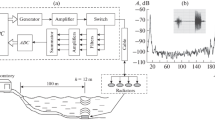Abstract
Some data on a high-frequency infrasound recorded within a range of 2–16 Hz (voice of the sea) in the water area of the Black Sea are given. Different parameters of the recorded infrasonic signal—the direction and phase velocity of arriving infrasonic waves, spectral composition, and coherence—have been studied. In the course of measurements, both wind and wave conditions in the water area of the Black Sea have been studied in detail. The collision of two atmospheric vortices was observed a few hours before the first arrivals of infrasonic waves, and the collision of differently directed sea waves was observed during infrasound recording. The direction of the arrivals of infrasonic waves coincides with the direction between the zone of collision of sea waves and the point of infrasound recording. The assumption was made that, in order to explain the observed infrasonic waves, it is necessary to use the mechanism responsible for the emission of infrasound into the atmosphere by standing surface waves formed due to the nonlinear interaction of surface waves propagating in opposite directions and to take into account the frequency-filtering properties of both wind-velocity and temperature stratifications of the atmosphere itself along the path of infrasound propagation. This assumption calls for additional verification.
Similar content being viewed by others
References
M. S. Longuet-Higgins, “A theory of the origin of microseisms,” Philos. Trans. R. Soc. London 243, 1–35 1950.
L. M. Brekhovskikh, “Radiation of infrasound by ocean waves into the atmosphere,” Izv. Akad. Nauk SSSR, Fiz. Atmos. Okeana 4 (4), 444–450 1968.
L. M. Brekhovskikh, V. V. Goncharov, V. M. Kurtepov, and K. A. Naugol’nykh, “On the problem of infrasound radiation into the atmosphere by surface waves in the ocean,” Izv. Akad. Nauk SSSR, Fiz. Atmos. Okeana 9 (9), 899–907 1973.
R. Waxler and K. E. Gilbert, “The radiation of atmospheric microbaroms by ocean waves,” J. Acoust. Soc. Am. 119, 2651–2664 2006.
C. H. Hetzer, R. Waxler, K. E. Gilbert, et al., “Infrasound from hurricanes: Dependence on the ambient ocean surface wave field,” Geophys. Res. Lett. 35, L14609 (2008). doi 10.1029/2008GL034614
K. T. Walker, “Evaluating the opposing wave interaction hypothesis for the generation of microbaroms in the eastern North Pacific,” J. Geophys. Res. 117 (C12) (2012). doi 10.1029/2012JC008409
V. V. Shuleikin, “On the voice of the sea,” Dokl. Akad. Nauk 3 (8), 259 1935.
V. V. Shuleikin, Physics of the Sea (Nauka, Moscow, 1083) [in Russian].
N. N. Andreev, “On the voice of the sea,” Dokl. Akad. Nauk 23 (7), 625 1939.
A. G. Semenov, “On "voice of sea” generation mechanism," Int. J. Geosci. 4, 116–128 2013.
M. Garces, J. Aucan, D. Fee, et al., Infrasound from large surf, Geophys. Res. Lett. 33 L05611 (2006). doi 10.1029/2005GL025085
G. Kallos, S. Nickovic, A. Papadopoulos, et al., “The regional weather forecasting system SKIRON: An overview,” in Proceedings of the Symposium on Regional Weather Prediction on Parallel Computer Environments, Vol. 15, p. 17 (1998).
G. J. Komen, L. Cavaleri, M. Donelan, et al., Dynamics and Modelling of Ocean Waves (Cambridge University Press, Cambridge, 1994).
Yu. N. Toloknov, A. I. Korovushkin, and K. G. Kozlov, “An automated hydrometeorological system,” in Environmental Control Systems (MGI, Sevastopol, 1998), pp. 12–17 [in Russian].
Y. Cansi, “An automatic seismic event processing for detection and location: the PMCC method,” Geophys. Res. Lett. 22, 1021–1024 1995.
I. P. Chunchuzov, G. A. Bush, and S. N. Kulichkov, “On acoustical impulse propagation in a moving inhomogeneous atmospheric layer,” J. Acoust. Soc. Am. 88 (1), 455–466 1990.
I. P. Chunchuzov, S. N. Kulichkov, O. E. Popov, and V. G. Perepelkin, “The propagation of an acoustic pulse in a near-ground atmospheric waveguide,” Izv., Atmos. Ocean. Phys. 46 (5), 597–607 2010.
Author information
Authors and Affiliations
Corresponding author
Additional information
Original Russian Text © V.G. Perepelkin, S.N. Kulichkov, I.P. Chunchuzov, I.A. Repina, 2015, published in Izvestiya AN. Fizika Atmosfery i Okeana, 2015, Vol. 51, No. 6, pp. 716–728.
Rights and permissions
About this article
Cite this article
Perepelkin, V.G., Kulichkov, S.N., Chunchuzov, I.P. et al. On experience in recording the voice of the sea in the water area of the Black Sea. Izv. Atmos. Ocean. Phys. 51, 639–650 (2015). https://doi.org/10.1134/S0001433815050102
Received:
Accepted:
Published:
Issue Date:
DOI: https://doi.org/10.1134/S0001433815050102




